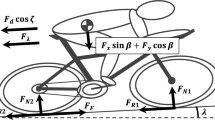Abstract
In this study, methods for data acquisition, analysis, modelling, and simulation of performance parameters in road cycling on real tracks were developed and evaluated. A simulator was designed to facilitate the measurement in a laboratory environment. The simulation included real height profiles and a video playback that was synchronised with the cyclist’s current virtual position on the track, and online visualisation of course and performance parameters. Field data obtained on mountain tracks in this study were compared with the state-of-the-art mathematical model for road cycling power, established by Martin et al. (J Appl Biomech 14: 276–291, 1998), which accounts for the gradient force, air resistance, rolling resistance, frictional losses in wheel bearings and inertia. The model described the performance parameters accurately with correlation coefficients of 0.96–0.99 and signal-to-noise ratios of 19.7–23.9 dB. It was shown that the mathematical model could be implemented on an ergometer for simulating rides on real courses, providing similar quality measures when comparing field and simulator measurements.








Similar content being viewed by others
References
di Prampero PE, Cortili G, Mognoni P, Saibene F (1979) Equation of motion of a cyclist. J Appl Physiol 47(1):201–206
Martin JC, Milliken DL, Cobb JE, McFadden KL, Coggan AR (1998) Validation of a mathematical model for road cycling power. J Appl Biomech 14:276–291
Olds TS, Norton KI, Craig NP (1993) Mathematical model of cycling performance. J Appl Physiol 75(2):730–737
Olds TS, Norton KI, Lowe EL, Olive S, Reay F, Ly S (1995) Modeling road-cycling performance. J Appl Physiol 78(4):1596–1611
Atkinson G, Brunskill A (2000) Pacing strategies during a cycling time trial with simulated headwinds and tailwinds. Ergonomics 43(10):1449–1460
Atkinson G, Peacock O, Passfield L (2007) Variable versus constant power strategies during cycling time-trials: prediction of time savings using an up-to-date mathematical model. J Sports Sci 25(9):1001–1009
Gordon S (2005) Optimising distribution of power during a cycling time trial. Sports Eng 8(2):81–90
Maronski R (1994) On optimal velocity during cycling. J Biomech 27(2):205–213
Wolf S, Dahmen T (2010) Optimierung der Geschwindigkeitssteuerung während Zeitfahrten im Radsport. In: Link D, Wiemeyer J (eds.) Sportinformatik trifft Sporttechnologie, 8. Symposium der dvs-Sektion Sportinformatik, September, 15–17, Darmstadt, pp 235–239
Lim AC, Homestead EP, Edwards AG, Carver TC, Kram R, Byrnes WC (2011) Measuring changes in aerodynamic/rolling resistances by cycle-mounted power meters. Med Sci Sports Exerc 43(5):853
Dahmen T, Saupe D (2011) Calibration of a power-velocity-model for road cycling using real power and height data. Int J Comput Sci Sport. IACSS Press, Austria (to appear)
Schoberer E (1994) Operating instructions for the srm training system. http://www.srm.de/index.php/de/support/phoca-down-test/category/14-powermeter (date accessed: Aug, 22th, 2011)
Gressmann M (2002) Fahrradphysik und Biomechanik. Technik – Formeln – Gesetze, 7. a. edn. Delius Klasing Verlag
Wilson D, Papadopoulos J, Whitt F (2004) Bicycling science, 3 edn. The MIT Press, Massachusetts
Cyclus2 website. http://www.cyclus2.com/en/index.htm, date accessed: Aug, 10th, 2011
Saupe D, Lüchtenberg D, Röder M, Federolf Ch (2007) Analysis and visualization of space–time Variant parameters in endurance sports training. Proceedings of the 6th International Symposium on Computer Science in Sports, IACSS
Dahmen T, Byshko R, Saupe D, Röder M, Mantler S. Modeling, simulation and validation of cycling time trials on real tracks. Konstanz Online Publication System. Retrieved from http://nbn-resolving.de/urn:nbn:de:bsz:352-133144
Acknowledgments
We thank Dr. Dietmar Lüchtenberg of the Department of Sport Science of the University of Konstanz and the anonymous reviewer for discussions and support. A part of this work was carried out while the third author was a Visiting Research Fellow at RSISE, Australian National University, Canberra, whose support is gratefully acknowledged.
Author information
Authors and Affiliations
Corresponding author
Additional information
This research was supported by the DFG Research Training Group GRK 1042, “Explorative Analysis and Visualisation of Large Information Spaces”.
Rights and permissions
About this article
Cite this article
Dahmen, T., Byshko, R., Saupe, D. et al. Validation of a model and a simulator for road cycling on real tracks. Sports Eng 14, 95–110 (2011). https://doi.org/10.1007/s12283-011-0076-1
Published:
Issue Date:
DOI: https://doi.org/10.1007/s12283-011-0076-1




